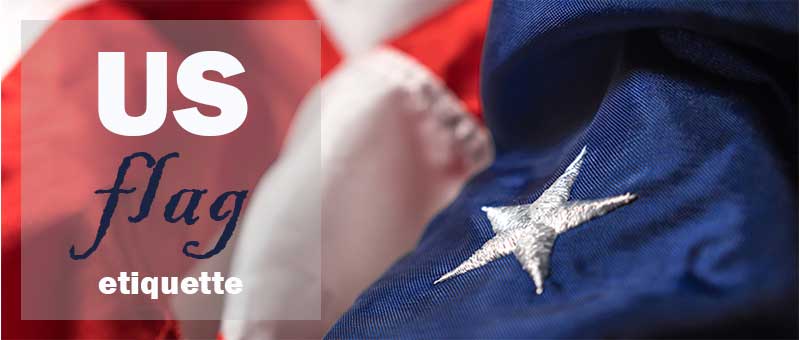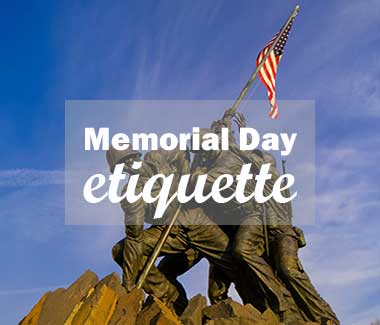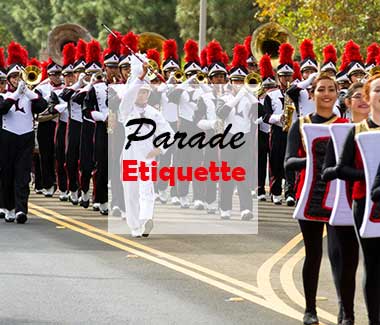
US Flag Etiquette
Flag etiquette has been codified under the “Flag Code”. These codified rules of etiquette provide guidance to show respect to the flag and offer instruction for how the flag may and may not be used.
- Never lower the flag to anything or person.
- Only fly it upside down if in distress.
- Do not use the flag as a covering, drapery, or decoration of any kind. Red, white, and blue bunting may be used with the blue strip at the top.
- Never use the flag for advertising.
- Never use the flag on any uniform or costume that is not an official military, police, fire, or patriotic organization.
- Never alter the flag by attaching to or placing on any word, mark, number, insignia, or any type of symbol.
- Never use the flag to hold any item.
The flag must never touch the ground or any other object.
The flag must be passed to prepared arms.
Before storing, the flag etiquette requires that the flag be folded properly.
If needed, the flag must be repaired or cleaned.
If a flag becomes too worn to be a symbol of the United States, it must be burned in a dignified way. (Please note: check with your local American Legion Post for ceremonial flag disposal services).
The Flag Outdoors
- If displaying a flag on a staff, the flag must be flown at the top of the staff, except if the flag must be flown at half-staff.
- If the U.S. flag is flown on a flagpole with a different flag (such as a community or state flag) the flag on top must be the U.S. flag, except for a church pennant if a Navy chaplain is conducting services for Naval personnel on a ship at sea.
- If flown over a street, the flag must be vertically hung. The union (the union is the upper left-hand corner, or stars) must be to the east or north.
- When the flag is flow over a sidewalk, keep the union farthest from a building.
- If the U.S. flag is flown with community or state flags on different flag poles, flag etiquette requires that the U.S. flag be flown to its own right.
- No other flag may be larger than the U.S. flag.
- No other flag can be flown above the U.S. flag.
- The U.S. flag must be the first raised and last lower.
Flag Etiquette When U.S. Flag Flown with Flags of Different Countries
If the U.S. flag is flown with a flag from other countries, flag etiquette requires that the flags are flown on separate poles at equal height.
The flags must be equal size.
The flags must be lowered and raised at the same time.
A nation’s flag cannot be flown above another nation’s flag.
Lowering and Raising the Flag
Raise the U.S. flag quickly and lower the U.S. flag slowly. Normally, the U.S. flag should be flown after sunrise and before sunset. If flown at night, the U.S. flag must be lighted.
If appropriate, salute the U.S. flag as it is lowered and raised. The salute is held until the flag is unsnapped from the halyard or through the last note of music, whichever is the longest.
The U.S. Flag Indoors
The U.S. flag must be displayed to its own right when displayed with other flags.
If the U.S. flag is crossed with another flag, it must be to its own right.
If the U.S. flag is displayed next to a wall, the upper left must be at the top, to the observer’s left.
Etiquette for Parading and Saluting the U.S. Flag
In a procession, the U.S. flag must be to the marchers’ right.
If other flags are carried, the U.S. flag should be front and center or to the right of the other flags. Everyone should salute the flag.
Salute Etiquette
During a salute, everyone must come to attention. Anyone uniformed should use a formal salute.
Anyone that is a citizen and not wearing a uniform salutes by:
- Place your right hand on top of your heart.
- Men wearing hats must remove them and hold them at their left shoulder (with their hand over their heart).
- Organization members standing in formation should salute when the person in charge give the command.
The Pledge of Allegiance and National Anthem Etiquette
Face the flag, salute, and stand at attention when giving the pledge of allegiance.
If the anthem is played, when the first note is heard, salute and hold it until the last note. Direct the salute toward the U.S. flag (or salute toward the music if there is no flag displayed).
Etiquette for the Flag in Mourning
When the U.S. flag is flown at half-staff it should be hoisted to the top first and then lowered ½ way between the bottom and top of the staff.
When lowering, the U.S. flag should again be hoisted to the top first, and then lowered.
Memorial Day flag etiquette requires that the U.S. flag be flown at half-staff from morning until noon and then the flag should be flown at the top from noon until sunset.
For mourning designated government leaders or at the order of a governor or the president, the U.S. flag should be flown at half-staff.
The U.S. flag is placed with the upper left hand corner over the left shoulder and head when covering a casket. Do not lower it with the casket.


